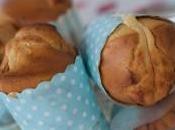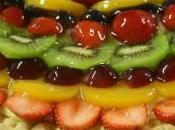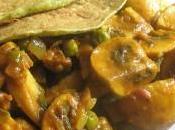
(scroll down for english version)
Se lo scorso anno il protagonista del Parmigiano Reggiano Chef è stato lo Smart Cooking (al quale ho partecipato con la mia pizza di carne), la competizione quest’anno si sposta oltre confine alla ricerca di ricette appartenenti ad altre culture, da rivisitare secondo la propria fantasia mediante l’inserimento tra gli ingredienti del Parmigiano stesso, eccellenza indiscussa del nostro patrimonio gastronomico.

Oggi vi porto nel vicino Oriente, facendovi conoscere un piatto tipico della cucina araba costituito da un fagottino di pasta lievitata che si presta per essere farcito con carne, formaggio e/o verdure ed aromatizzato con un’infinità di spezie.
Io, in perfetto mood formaggioso, sono partita da questa ricetta di Chef in disguise per creare la mia personale versione di fata’ir o fatayer, utilizzando ingredienti facilmente reperibili: ricotta fresca, pecorino, limone, menta, semi di sesamo ed ovviamente il Parmigiano Reggiano.
Vi lascio solo immaginare il profumino che si è scatenato in cucina durante la loro cottura! Mi raccomando vanno mangiati rigorosamente caldi affinché il formaggio all’interno sia morbido. I miei erano anche troppo grandi come dimensione…la prossima volta mi sono ripromessa di farli più piccini per ottenere dei bocconcini perfetti per un buffet/aperitivo.
Se siete curiosi di sapere come si preparano seguitemi in cucina!
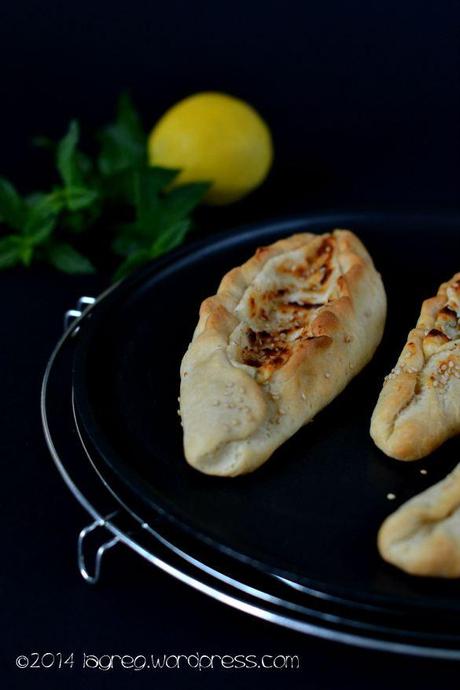
FATAYER A MODO MIO (per 12 barchette grandi)
- 480 gr di farina 0
- 60 ml di olio vegetale (per me di girasole bio)
- 100 gr di yogurt bianco naturale
- 4 gr di lievito secco attivo
- 100 ml di acqua tiepida
per il ripieno:
- 400 gr di ricotta fresca di pecora
- 200 di Parmigiano Reggiano grattugiato (per me invecchiato 30 mesi)
- 100 gr di Pecorino romano grattugiato
- 4 cucchiai di latte
- scorza di un limone bio
- un mazzetto di menta fresca
- baking powder (vedi note)
per finire:
- olio extravergine di oliva
- semi di sesamo
In una ciotolina sciogliete il lievito con lo zucchero e 100ml di acqua ed attendete che si formino le bollicine. In una ciotola mescolate insieme la farina e il baking powder fino a quando sono ben amalgamati. Unite l’olio e lo yogurt ed infine la miscela di acqua e lievito; lavorate l’impasto fino ad ottenere una palla omogenea che non si attacca alle vostre mani. Per dare struttura all’impasto sbattetelo energicamente sul piano di lavoro per 7-10 volte.
Oliate leggermente una ciotola e trasferitevi l’impasto; coprite con uno strofinaccio pulito o con pellicola e mettete in un posto caldo fino al raddoppio (se andate di fretta, accendete il forno a 200°C e posizione una griglia a metà. Spegnete il forno, mettete un telo da cucina sulla gliglia e posizionateci sopra la ciotola contenente l’impasto. Chiudete il forno e lasciate lievitare per 10-15 minuti).
Una volta raddoppiato l’impasto dividetelo in palline della grandezza di un uovo (io ne ho ottenute 12) e coprite con uno strofinaccio; lasciate riposare per 10 minuti.
Stendete ciascuna pallina di impasto dandole una forma ovale. Posizionate al centro una generosa dose di ripieno dopodiché piegate un lato dell’impasto verso l’interno premendo leggermente; ripiegate a questo punto il lato opposto. Ripetete la stessa operazione per le altre estremità in modo da ottenere delle barchette. Io in più ho creato un effetto zigrinato, ondulando con le mani l’impasto.
Pennellate con olio (o latte o rosso d’uovo) ed attendete 10-15 minuti prima di infornare.
Riscaldate il forno a 200°C ed una volta a temperatura posizionate al centro per i primi 15 minuti dopodiché spostate in altro fino a doratura.
Note:
Se la vostra intenzione è quella di consumare i fatayer subito dopo la cottura utilizzate il baking powder indicato negli ingredienti (esso infatti aumenta la morbidezza dell’impasto ed aiuta la lievitazione in cottura). Se al contrario avete pianificato di congelare o di mangiare i fatayer entro un paio di giorni non aggiungete baking powder all’impasto perché lo renderebbe troppo morbido e gommoso una volta raffreddato.
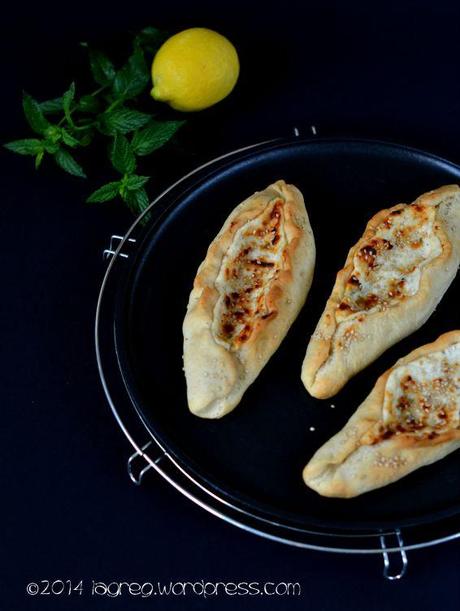
CHEESE PASTRY FATAYER (MY STYLE) makes 12 turnovers
- 480 gr AP flour
- 60 ml vegetable oil
- 100 gr plain yogurt
- 4 gr di dry yeast
- 100 ml warm water
- 1 teaspoon baking powder (see notes)
for the stuffing:
- 400 grfresh ricotta cheese
- 200 grated Parmigiano Reggiano cheese
- 100 gr grated Pecorino cheese
- 4 tablespoons milk
- grated lemon rind from 1 organic lemon
- small bunch fresh mint
to finish:
- extravirgin olive oil
- sesame seeds
Proof the yeast by mixing it with the sugar and 100ml water in a cup, the yeast should foam and bubble if it doesn’t then it has gone bad and you need to replace it with new package.
In a bowl whisk together the flour and baking powder till combined. Add the oil and then rub it into the flour mix with your fingertips. Add the yogurt and the water yeast mixture and knead the dough untill it forms a smooth soft ball that doesn’t stick to your hands (a tip from a bakery owner I know, pick up the dough and slam it into the table 7-10 times during kneading. That will give your baked goods that fluffy interior).
Cover a bowl with a little olive oil,place your dough it and cover the bowl with a clean towel or plastic wrap and leave it in a warm place untill it doubles in size (If you are short on time, heat your oven to 200 C and place the rack in the middle. Turn it off. Place a clean towel on the rack and place the bowl with your covered dough on the towel and leave it in the closed oven. It will double in size in 10-15 minutes)
Cut the dough into egg sized balls and cover them with a clean towel and allow them to rest for 10 minutes.
Roll each dough ball into an elongated oval shape. Fold one edge of the dough over and press it with your finger tips to seal it. Fold over the opposite side and tuck the dough under the pastry boat. Do the same with the opposite side. Once you’re done shaping the pastry gently press the top folds to adhere the dough to the cheese..this helps to prevent the pastry boats from opening up when you bake them
I usually brush them with some milk but you can egg wash them or brush them with some olive oil to give them a beautiful golden color when they bake. Allow them to rest for 10-15 minutes after shaping before baking them
Bake on the middle rack in an oven that you have preheated to 200 C until the bottom is golden brown then place under the broiler until the tops are golden brown.
Notes:
If you are going to consume the fatayer soon after baking , keep the baking powder (It increases the fluffiness of the dough and allows it to rise better in the oven). If you plan on storing them or eating them over a couple of days omit the baking powder because the fatayer remain softer and more chewy when they are cooled and stored without the baking powder.(baking powder results in the baked goods hardening a little when they are cold)
